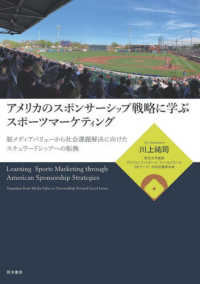Full Description
Supervising and Assessing Student Nurses and Midwives in Clinical Practice is a practical guide for healthcare practitioners responsible for the supervision and assessment of students.
The book is designed to help practice supervisors and practice assessors:
to identify and plan for a range of learning opportunities
to consider what is possible for learning and assessment in their area
to get ready for and deliver the best learning experiences that they can to prepare students for their role as future nurses and midwives.
Activities, top tips, examples and scenarios all help the reader to set the principles in context and to support students in achieving the NMC's standards of proficiency.
Covering the learning environment and culture, interprofessional supervision, coaching models and feedback, methods and types of assessment, simulation-based learning, and the future of practice learning, the book aims to help individuals and organisations to create the best environment for supporting, supervising and assessing students in practice.
"This is a contemporary text that is truly a practical guide that steers and supports. It is written in an accessible and user-friendly way, helping the reader see through the complexities that are inherently associated with practice assessment... I sincerely recommend this book to students and practitioners who learn and practise together with the overall goal of offering high-quality care that is safe and effective."
From the Foreword by Professor Ian Peate, OBE FRCN
Contents
About the authors; Foreword; Abbreviations; Introduction
1. The context of practice supervision and assessment
Debbie Roberts
1.1 Introduction
1.2 Clinical wisdom
1.3 The changing landscape
1.4 Summary
2. Developing the education team
Jacqueline Leigh and Debbie Roberts
2.1 Introduction
2.2 Global standards for the initial education of professional nurses and midwives
2.3 The quality practice learning environment
2.4 NMC Future nurse: Standards of proficiency for registered nurses; and Realising professionalism: Part 3: Standards for education and training
2.4 NMC Part 2: Standards for student supervision and assessment - implications for practice teaching, learning and assessment
2.5 Managing disagreement about student progression
2.6 Summary
3. Using coaching conversations and coaching models to promote effective supervision and assessment
Jacqueline Leigh, Kisma Anderson, Anne Medcalf, Andrea Surtees and Wendy Sutton
3.1 Introduction
3.2 Coaching and mentoring
3.3 Promoting effective supervision, assessment and clinical leadership development through coaching in clinical practice
3.4 Exploring the core concepts of coaching conversations
3.5 Coaching spectrum
3.6 Exploring the qualities of the supervisor who effectively applies coaching conversations
3.7 Clinical leadership development through engaging in coaching conversations
3.8 The GM Synergy coaching model
3.9 Summary
4. Interprofessional supervision of student learning
Joanna Barlow, Leigh Campbell, Zoe Tilley and Jo Pierce
4.1 Introduction
4.2 Interprofessional learning in the healthcare environment
4.3 Interprofessional supervision in healthcare to foster learning
4.4 Role of the allied health professional as a practice supervisor
4.5 Summary
5. Facilitating learning through feedback and feedforward
Peggy Murphy and Hannah Dixon
5.1 Introduction
5.2 What is feedback in clinical practice?
5.3 What is feedforward in clinical practice?
5.4 The principles of effective feedback
5.5 Feedback for learning
5.6 The feedback conversation: feedback as a reciprocal process
5.7 Professional requirements for feedback
5.8 Peer feedback
5.9 Ways to encourage students to engage with feedback
5.10 Managing difficult conversations
5.11 Summary
6. Supporting students through challenging practice supervision and assessment situations
Elaine Beaumont, Gail Norris and Caroline J. Hollins Martin
6.1 Introduction
6.2 Student support in the learning environment
6.3 How does clinical supervision work in the context of student trauma?
6.4 Compassionate mind training
6.5 Summary
7. What is assessment and what are we assessing?
Debbie Roberts
7.1 Introduction
7.2 The practice assessor
7.3 Assessment practices
7.4 Types of assessment
7.5 Self-assessment
7.6 Patient/client/consumer/service user engagement in assessment
7.7 Assessment as an emotional endeavour
7.8 Summary
8. Using simulation-based education for supervision and assessment of student learning
Leah Greene
8.1 Introduction
8.2 Background
8.3 Technology-enhanced learning
8.4 Writing effective scenarios
8.5 Being 'supervisor ready'
8.6 Using simulation for assessments
8.7 Summary
9. The future of practice learning
Jacqueline Leigh
9.1 Introduction
9.2 Creating the best environment for practice learning and supervision and assessment
9.3 The practice learning environment
9.4 Exploring the concepts of a learning organisation
9.5 Applying leadership skills to create opportunities for innovative practice learning and to promote the quality practice learning environment
9.6 Applying the concepts (five disciplines) of a learning organisation together with the qualities and behaviours of the leader to promote effective practice learning
9.7 Applying strategies for creating innovative student learning experiences
9.8 Alternative models of nurse education
9.9 Summary
Index








